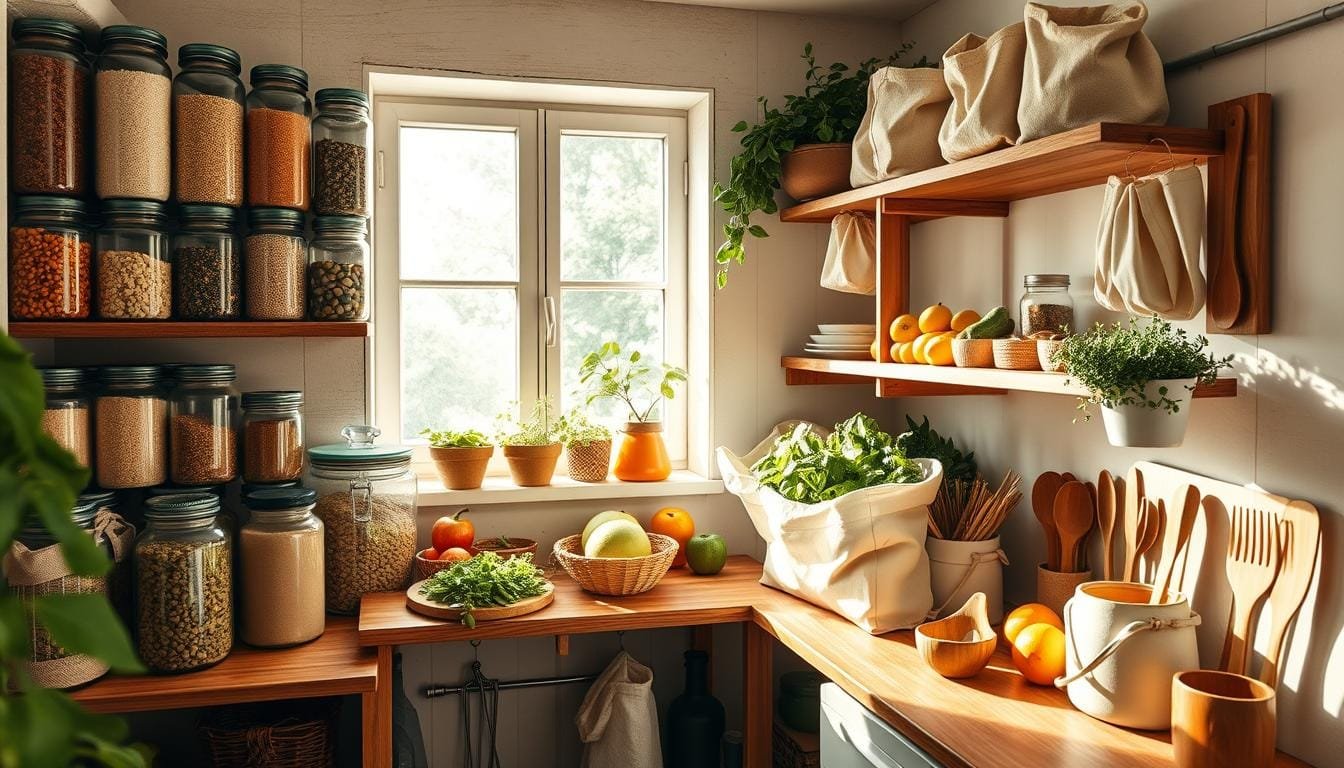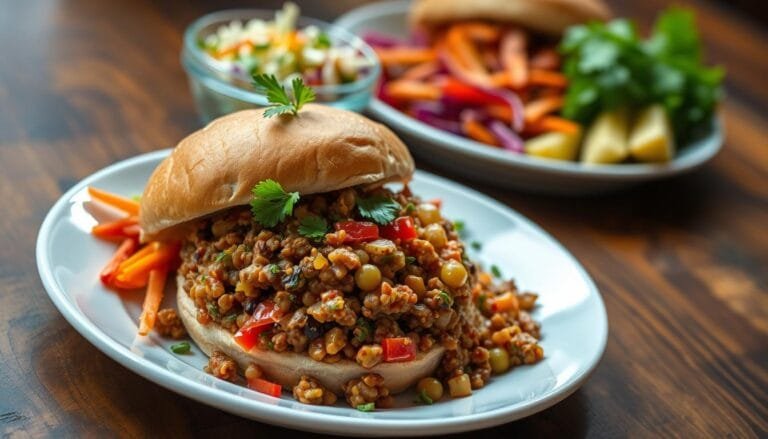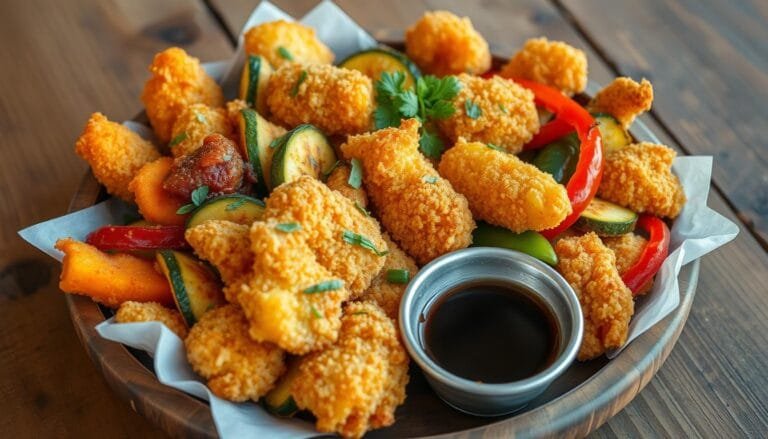Standing in my kitchen, I see the clutter of single-use plastics and growing food waste. The numbers are shocking – nine billion tons of single-use plastic are used every year. Even the deepest parts of the ocean have microplastics. It’s a harsh truth we must face.
Yet, there’s hope in the Zero Waste Movement. It started with the first Earth Day in 1970. It teaches us to Reduce, Reuse, Recycle. I’m starting a journey to make my kitchen sustainable. It will help the planet and make my life easier.
In this guide, I’ll share tips for a greener kitchen. We’ll look at smart storage and ways to reduce waste. Together, we’ll make your kitchen more eco-friendly and find the joy in living sustainably. Let’s discover the magic of a zero-waste pantry.
Understanding Sustainable Kitchen Organization
Starting a zero-waste lifestyle is empowering, and it begins in our kitchens. By changing how we organize our kitchens, we can lessen our environmental harm. We also save money and enjoy our food more.
Benefits of a Zero-Waste System
Using a zero-waste system in the kitchen has many advantages. It cuts down on food waste, saves natural resources, and lowers our carbon footprint. By reducing waste, we protect the environment and save on grocery and disposal costs.
A zero-waste kitchen also encourages healthier eating and a greater appreciation for food.
Environmental Impact of Kitchen Waste
Kitchen waste has a big environmental impact. Food scraps, packaging, and single-use items pollute landfills and waste resources. By cutting down on kitchen waste, we help solve these problems and make a real difference.
Getting Started with Sustainable Practices
Starting a sustainable kitchen is easy. Begin by buying reusable, durable, and eco-friendly items. Choose long-lasting kitchen tools and avoid single-use items. Pick energy-efficient appliances too.
Plan your meals to reduce food waste and find creative ways to reuse kitchen items. Small, consistent actions can lead to a zero-waste lifestyle that benefits the planet.
“The greatest threat to our planet is the belief that someone else will save it.”
Adopting a zero-waste kitchen is a key step towards a sustainable future. By understanding the benefits and the harm of kitchen waste, we can all help make the world cleaner and greener.
Essential Zero-Waste Pantry Tips for Beginners
Starting a sustainable kitchen can seem daunting. But, with a few easy tips, you can cut down on waste and live greener. Remember, “best by” dates are for quality, not safety. Use your senses to check if food is good to eat.
Begin by getting rid of any bad or unwanted food. This makes your pantry fresh and ready for new habits. Then, pick a spot for items that expire soon. This helps you use them before they go bad.
Proper storage is vital to avoid waste. Put things where they belong, thinking about temperature and humidity. Also, label everything so you know what you have and when you got it. This stops you from forgetting food and wasting it.
- Ignore “best by” dates and use your senses to evaluate food quality
- Clear out spoiled or unwanted items to start with a clean pantry
- Create a “use this first” zone for perishable items
- Store everything in the right place, considering temperature and humidity
- Label all pantry items with contents and storage dates
These simple tips can help you start a greener kitchen. Every little change helps a lot! So, start today and see the difference.
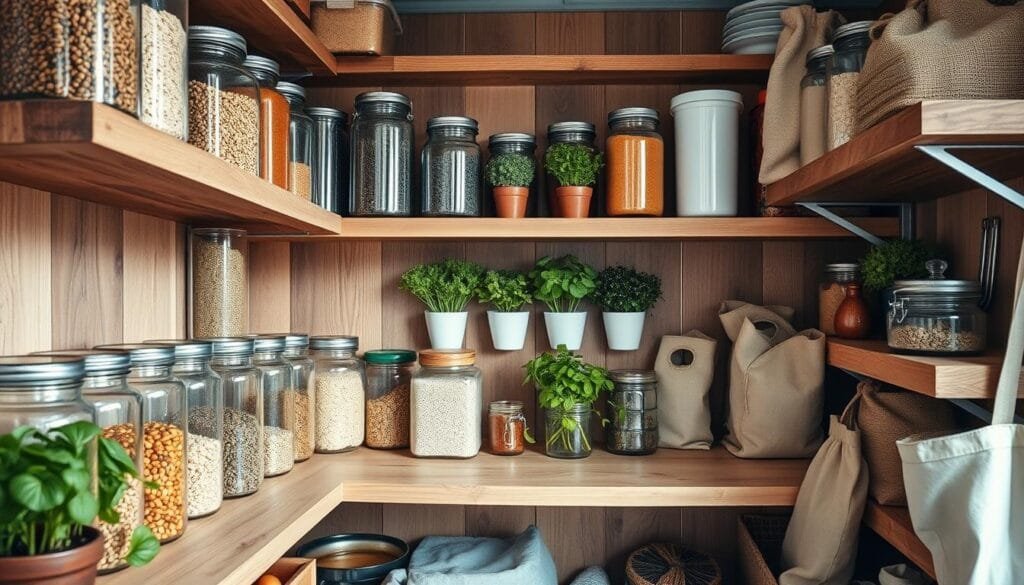
Eco-Friendly Storage Solutions and Containers
We’re all trying to make our kitchens more sustainable. One key area is the storage solutions and containers we use. It’s time to say goodbye to plastic and hello to eco-friendly options that are better for our planet and health. Let’s look at some top choices.
Glass and Metal Container Options
Glass and metal containers lead the way in sustainable storage. Glass jars are easy to recycle, while stainless steel containers are durable and stylish. These materials are safe, reusable, and much better for the environment than plastic.
Biodegradable Storage Alternatives
If you want even greener options, biodegradable storage is the answer. Cornstarch bags, recycled paper containers, and cotton bags are great for storing dry goods and produce. They naturally break down, reducing kitchen waste’s environmental impact.
Natural Material Organizers
For a natural look in your pantry, try organizers made from renewable resources. Wooden crates, bamboo bins, and natural fiber baskets can store items and beautify your kitchen. They add a touch of natural beauty.
Using these eco-friendly storage solutions and containers helps reduce our environmental impact. It makes our pantries healthier, more organized, and beautiful. Every small step towards sustainability is important!
Smart Food Storage Methods to Minimize Waste
Using smart food storage techniques is key to reducing kitchen waste. It helps us live more sustainably. By storing food efficiently, we can keep groceries fresh longer, reduce waste, and save money.
Bulk buying is a great way to cut down on waste. Buying grains, beans, and spices in bulk saves packaging and helps us plan meals. Use reusable glass jars or airtight containers to keep food fresh and reduce plastic use.
| Storage Solution | Waste Reduction Impact |
|---|---|
| Reusable vegetable bags | Up to 70% reduction in single-use plastic bag consumption |
| Proper produce storage in fridge | Up to 50% increase in shelf life of produce |
| Airtight glass food storage containers | Up to 60% reduction in food waste due to spoilage |
| Parchment paper for meat and fish | 30% reduction in plastic usage for food storage |
| Optimized fridge organization | 20% decrease in food waste |
Right refrigeration and freezing can keep food fresh. Make sure your fridge is at the right temperature. Use crisper drawers and bins for produce. For freezing, use airtight containers or silicone bags to keep flavors and nutrients in.
For non-perishable foods, try dehydrating or canning. These methods keep food fresh longer and save energy. Learning these skills can greatly reduce waste and save money.
Smart food storage helps reduce waste and supports a sustainable future. With planning and the right storage, you can keep your kitchen stocked while helping the environment.
Bulk Buying Strategies for Sustainable Shopping
Buying in bulk can change your kitchen for the better. It cuts down on packaging waste and saves money. But, where do you find these items, and how do you use them best?
Where to Find Bulk Items
Start at your local co-op, farmers market, or CSA program. They have unpackaged grains, nuts, dried fruits, and more. You can also find bulk spices, oils, and cleaning products for your home.
What to Buy in Bulk
Focus on non-perishable items you use often. Think grains like rice, quinoa, and oats. Also, nuts, seeds, and dried legumes are good choices. Buying in bulk means less packaging and a steady supply of essentials.
Storage Solutions for Bulk Foods
Use clear, airtight containers to keep bulk foods fresh. Choose from glass, metal, or BPA-free plastic. Label them with what’s inside and when you bought it. A food dehydrator can also help make healthy snacks from bulk produce, reducing waste.
Embracing bulk shopping can greatly reduce your environmental impact and save money. Begin with small steps, try different items, and watch your zero-waste kitchen grow.
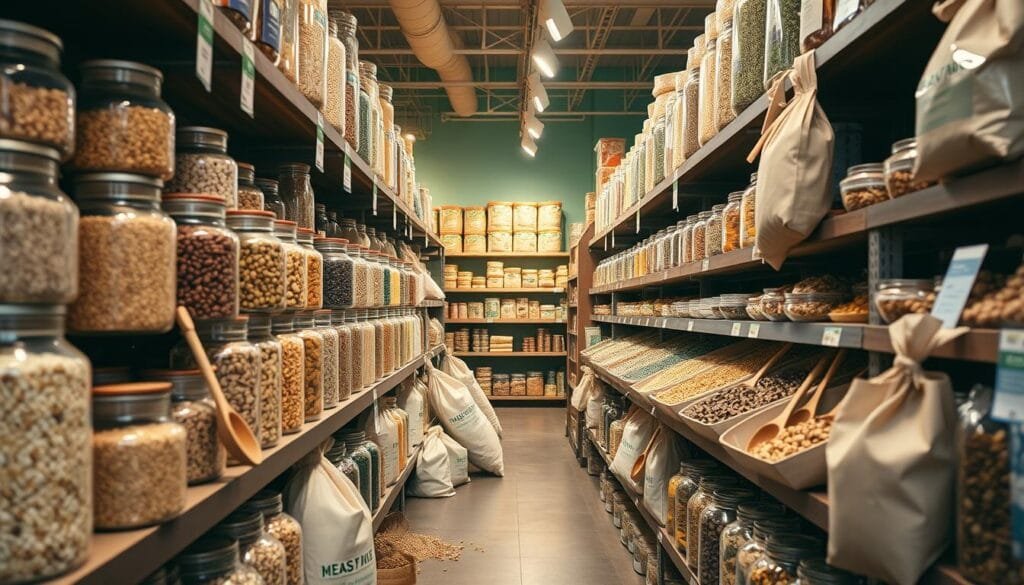
Organizing Your Pantry for Maximum Efficiency
Keeping your pantry organized is key for a smooth kitchen. It helps you cook faster and waste less food. Here are some tips to make your pantry tidy and clutter-free.
Begin by sorting your pantry into zones like grains, snacks, and baking. This makes finding what you need quick. Use vertical space with extra shelves or bins to store more and keep essentials easy to reach.
It’s important to regularly clean out expired items. Set aside time to toss old food and donate what’s left. This keeps your pantry tidy and helps the environment.
Invest in special storage like clear containers and adjustable shelves. These make your pantry look good and help you find ingredients fast. They save time and prevent food from getting lost.
Organizing your pantry makes your kitchen run better and helps the planet. Try these tips to make your pantry efficient and reduce waste.
“A well-organized pantry is the foundation for a stress-free and efficient kitchen.” – Culinary Expert, Jane Doe
Remember, your pantry should fit your life. Try different ways to organize until you find what works best for you. This will make your pantry efficient, sustainable, and convenient.
Natural Preservation Techniques for Extended Shelf Life
Using natural methods to preserve food can make it last longer and cut down on waste. Dehydrating and canning are two great ways to keep fresh produce good for longer after it’s picked.
Dehydrating and Canning Methods
Dehydrating removes moisture from fruits and veggies, stopping bacteria from growing and slowing down spoilage. You can use a dehydrator or your oven on the lowest setting. Canning seals food in jars or cans, keeping it fresh by stopping decay. Both are top choices for food preservation and sustainable storage.
Temperature Control Tips
Keeping the right temperature is essential for keeping food fresh. Put meat and dairy in the coldest part of the fridge, usually the back. Use the crisper drawer for less sensitive produce. Watching temperature control helps a lot in waste reduction.
Humidity Management
It’s also important to control humidity levels for sustainable storage. Use silica gel packets to keep grains and flours dry. Store produce in cloth bags or containers to keep the right humidity.
By using these natural food preservation methods, you can make food last longer, reduce waste, and help the environment.

Sustainable Label Systems and Inventory Management
Keeping your pantry organized is key to a sustainable kitchen. Eco-friendly labels made from recycled materials are a great start. They keep your pantry looking good and help cut down on waste. Choose reusable chalkboard labels that you can clean and reuse, saving you from constantly buying new ones.
Having a good inventory system is also important. It helps you keep track of when food expires. This way, you use up items before they go bad, reducing waste. Use plant-based inks for your labels to be kinder to the planet than regular ones.
- Utilize reusable chalkboard labels to reduce waste from disposable alternatives.
- Implement an inventory management system to track expiration dates and prevent food waste.
- Opt for plant-based inks when labeling to minimize the environmental impact.
Adopting sustainable labels and inventory management can make your pantry a green haven. These steps are simple but powerful. They help you waste less, save money, and make your kitchen more eco-friendly.
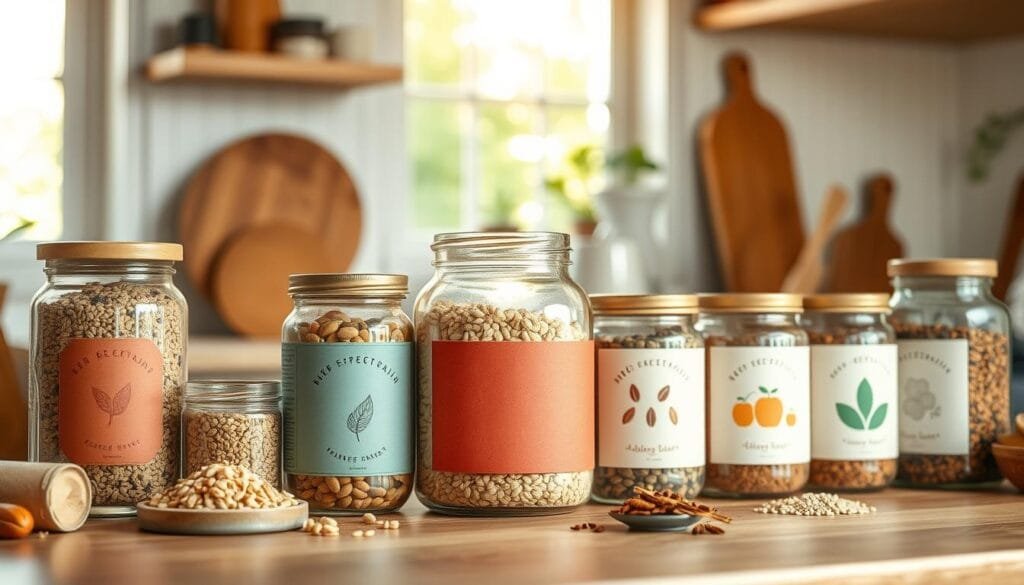
“Implementing sustainable label systems and inventory management is a game-changer for any eco-conscious kitchen.”
DIY Zero-Waste Kitchen Solutions
I’m always looking for ways to cut down on waste in my kitchen. Making my own sustainable solutions is very rewarding. From homemade cleaning products to using food scraps, there are many DIY projects to try.
I enjoy turning old containers into pantry organizers. Using wooden crates or mason jars on my shelves is both charming and practical. It helps me avoid clutter and waste. For cleaning, I use vinegar and baking soda instead of harsh chemicals.
Composting food scraps is a favorite of mine. It lets me make tasty dishes like vegetable stock. It also cuts down on food waste. I also use reusable glass jars for storage and drinking, reducing single-use plastics.
FAQ
What are the benefits of a zero-waste lifestyle?
How can I get started with sustainable kitchen practices?
What are some essential tips for beginners to reduce waste in the pantry?
What are some eco-friendly storage solutions for the pantry?
How can I practice smart food storage to minimize waste?
Where can I find bulk items to reduce packaging waste?
How can I organize my pantry for maximum efficiency?
What are some natural preservation techniques to extend food shelf life?
How can I create sustainable labeling and inventory systems for my pantry?
What are some DIY zero-waste kitchen solutions I can try?
Source Links
- https://foodrevolution.org/blog/zero-waste-kitchen-tips/
- https://zerowastekitchen.moveforhunger.org/5-tips-for-organizing-your-refrigerator-and-pantry-to-reduce-food-waste/
- https://jasminilkay.com/mastering-zero-waste-in-your-kitchen-achievable-strategies-for-a-sustainable-lifestyle/
- https://sustainlifejournal.com/zero-waste-kitchen-organization/
- https://www.netzerocompany.com/blogs/news/zero-waste-kitchen-organization-tips
- https://www.milkglasshome.com/zero-waste-pantry-staples/
- https://www.greenify-me.com/2019/09/zero-waste-pantry-essentials.html
- https://www.wearespruce.co/blogs/cleaning/pantry-organisation-without-plastic?srsltid=AfmBOorUVVitfLsSncnAD1vAbhJWZQq0U-YTNXr6WuITJKyV3hLskZg-
- https://mindfulofthehome.com/zero-waste-food-storage/
- https://solanacenter.org/2020/07/16/food-storage-for-waste-prevention/
- https://www.takechargeamerica.org/6-ways-to-minimize-food-waste-and-save-money/
- https://treadingmyownpath.com/2018/01/25/first-time-bulk-store/
- https://www.tastingtable.com/1674969/grocery-shopping-sustainability-tips/
- https://mindfulofthehome.com/zero-waste-grocery-shopping-tips/
- https://elegantsi.com/blog/how-to-organize-a-pantry
- https://ultimateacademy.com/professional-organizing-courses/professional-organizing-blog/pantry-organization/
- https://zerowastechef.com/2017/01/20/store-produce-without-plastic/
- https://www.theprairiehomestead.com/2021/09/how-to-store-a-years-worth-of-food-for-your-family-without-waste-and-overwhelm.html
- https://natureofthenorth.co/basics/long-term-food-storage-methods/
- https://designertrapped.com/brilliant-pantry-organization-ideas/
- https://www.epa.gov/sustainable-management-food/call-action-united-states-food-loss-waste-2030-reduction-goal
- https://www.thekrogerco.com/sustainability/zero-hunger-zero-waste/
- https://simplebites.net/how-to-move-towards-a-zero-waste-kitchen/
- https://zerowastechef.com/2018/01/28/a-zero-waste-kit-that-costs-zero-dollars/
